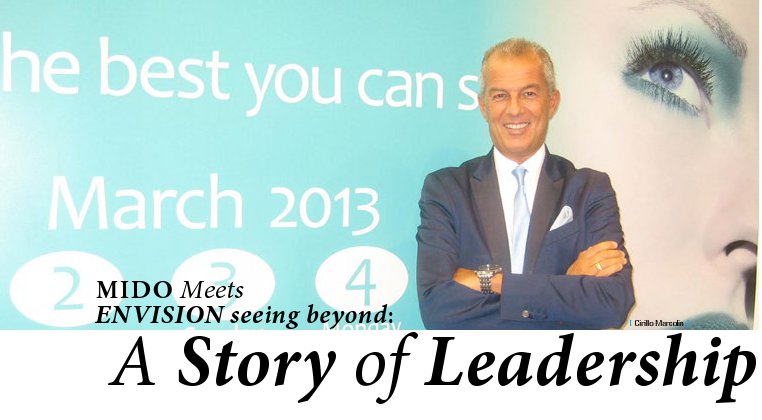By Paddy Kamen

- Matt Cevasco
Briot/WECO Canada is stronger than ever and President and General Manager Matt Cevasco is on the job – with an exciting new company to boot!
Canadian eyecare and lab professionals are no doubt familiar with Briot/WECO Canada. You may not be up-to-date, however, with developments in the company over the last few years. It’s a story of mergers, acquisitions and sound fundamentals that lead to superior products. Everyone benefits with the new synergies inherent in this dynamic international company and its leading-edge technologies and equipment.
Matt Cevasco sat down with Paddy Kamen, the editor-in-chief of Envision: seeing beyond, for an interview in September. He shared the story of Marc Abitbol, who has established an incredibly strong presence in the global medical manufacturing and technology sector.
Marc Abitbol, Ph.D., is the founder of Visionix, a company that develops, manufactures and sells wavefront-based technology. “In 2003, Visionix acquired Luneau, the leading French manufacturer of medical devices. Luneau has been in business since 1928 and is known for strong research and development and continuous improvement in products and services, including Visionix ophthalmic diagnosis systems based on wavefront technology,” says Cevasco. The companies provide complete solutions for eyecare professionals (ECPs) and optical labs in Europe, theU.S., the Far East and now Canada. It is Abitbol’s technology that forms the core of the Visionix instrument line.”
We will cover Visionix’s impressive refraction instrument in a moment. But first, more about the Briot/WECO connection.
In 2010, Luneau acquired Briot International and its WECO subsidiary from Belgium-based Buchmann Optical Holding. Briot International develops, manufactures and markets Briot and WECO edgers. With the merger, most managers and distribution systems remained in place. It was at this juncture that Matt Cevasco came on board as president and general manager for Briot/WECO Canada, Briot USA and Visionix.
“I had a strong background in the industry and I was excited about Abitbol’s goals for the company,” explains Cevasco. “He is very entrepreneurial and wanted to bring high-end solutions to a variety of markets. Abitbol is an innovator, a driver and an idea man. His approach is to find the people he believes can drive the business and then give them the tools they need to do the job.”
Cevasco notes that Abitbol’s business philosophy has found a happy home at Briot/WECO. “New product technologies have filtered into all sides of the business. For example, Weco was known for industrial heavy-duty equipment while Briot embodied smaller, user-friendly units. We’ve ported some of the best of Weco into Briot products and vice-versa, resulting in better products for both brands. We can meet the needs of anyone in the marketplace with product that is easy to use and reliable. This includes the optician who does not currently finish lenses.”
The Briot eMOTION is just one example of the innovation afoot at Briot/WECO. It is a new edging system that combines the best of Briot’s technologies and puts them within everyone’s reach. For perfect edging, glazing, tracing and drilling, including custom jobs, the eMOTION reduces time and labour while increasing precision. “This is a high-end, all-in-one machine and the reality is that this technology is so easy to use that there is no reason not to finish your own lenses,” explains Cevasco. “An industry survey showed that over 90 per cent of optical professionals said in-office edging increased their profits. Nearly as many said it also increased their patient base.”
A video demonstrating the eMOTION in action can be viewed at: http://www.briot-emotion.com/.
Cevasco is tremendously excited about the innovative, patented PowerMap™ technology from Visionix, which provides simultaneous multipoint measurements of all the parameters of a lens.
“We’re starting to see a major shift away from the traditional way of doing refraction which has been with us for the last 100 years. Wavefront technology has given us a way to obtain a more accurate objective refraction,” explains Cevasco. He goes on to illustrate: “This system allows the ECP to refract at the most precise level possible. The doctor in the exam room can now match advances in lens technology, which makes for a more satisfied patient.”
Visionix technology was developed by in-house scientists who were previously involved in the ‘Star Wars’ space project. It is based on Hartman Wavefront 3D technology. Visionix is a leader in the field, with the first wavefront product for industry applications in 1997 and the first full refraction line based on wavefront in 2009.
According to Cevasco, increasing numbers of optometrists say that the part of their job they like the least is refraction. “They tell us they would rather work on diseases of the eye. This is a tool for them to make the refraction process more effective and efficient. It allows super-accuracy while also being easy enough to use that it can be handed over to an assistant. I can teach anyone how to use it 10-15 minutes. Simplicity, accuracy and speed lead to patient satisfaction and better overall experience in the practice.”
Briot/WECO Canada and Visionix are based inToronto, with four sales reps who demonstrate the products and ensure customer expertise and satisfaction.Western Canada distribution is handled through Insight Medical. “All our representatives have many years of experience in servicing the equipment, which we are happy to do for the life of the machines,” says Cevasco.
It is no longer true that high-end equipment is available only to the few. Cevasco is proud to be associated with leading-edge technology that is available to all market segments. He is also proud of the innovative companies – Briot/WECO Canada and Visionix – that he leads under the very able and entrepreneurial Marc Abitbol, a visionary in the vision care industry. “We will continue to innovate with the goal of making the eyecare industry more efficient and effective,” says Cevasco. “When we have happy clients, they have satisfied patients. Everyone has a good experience and everyone wins.”







